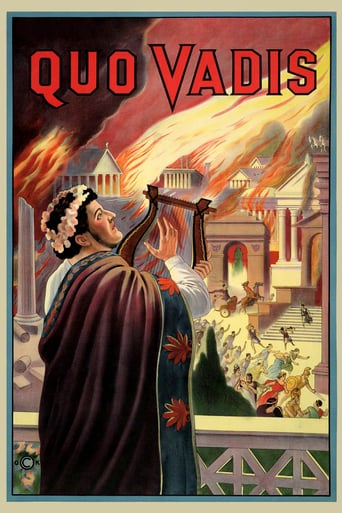

At the dawn of the cinema, it was Italy where actually great spectacles were born. They had the locations at hand. Along the famous CABIRIA made a few years later (which also celebrated its centenary), QUO VADIS by Enrico Guazzoni based faithfully upon Henryk Sienkiewicz's novel, not only stunned the audience of the time being played in many road theaters but also set the standards for the very genre (as many reviewers have stated before me). More to say, Sienkiewicz's novel became one of the top literary sources which inspired so many filmmakers to bring the first century Rome, the decadence and fall of emperor Nero (reigning 54-68 A.D) and the rise of Christianity in the center of the empire to screen. The most famous version enjoying the international renown to this day is, of course, Mervyn LeRoy's (1951). However, great as the ultra popular QUO VADIS is, this one appears to be more faithful to the novel but requires a very special perception. Allegedly, Henryk Sienkiewicz himself saw this motion picture which we can see now after the restoration co-financed by the Lumiere Project.Amleto Novelli, Carlo Cattaneo, Cesare Moltini, Lea Giunchi, Gustavo Serena...the cast of the time do not make any special impression on us these days. Similarly to stagy silent movies of the 1910s, they may appear as 'phantoms' moving within the frame of the screen without desirable close-ups that would instill some understanding of the characters' feelings. Yet, that is not the strength of the movie.The major phenomenon of this silent QUO VADIS (there was another silent version with Emil Jannings as Nero which occurred a flop) are the moments of great aesthetic intensity. Mostly operatic in its feeling, it supplies a viewer with an unbelievable 'image' of the novel's content. It is not the novel so to say 'filmed' or pictured but art of a new medium (at the time) which beautifully combines literature and cinema. With no words necessary, the movie does not disturb imagination but rather inspires its unknown spheres. From the banquet at Nero's through the fire of Rome, the shots of the arena and St Peter meeting Christ on the Appian Way (the climax of the story here though not so historically chronological), the scenes may still occur highly entertaining. We watch a distant past, we have a glimpse of early cinema's vision and both the storytelling and the execution of the content become to us quite 'archaic.' That aspect appears as tremendously involving.There is not much to say about performances, about music score, about special effects. Yet, there is something inspiring about depriving oneself of all the prefabricated expectations of an 'entertaining' movie, about beating the 'cliches' of 'silent film equals to boring film' and allowing oneself to view it in a fresh manner as if it still had something to offer after more than a century. And believe me, it does.
... View MorePerhaps the best film made to its date, 'Quo Vadis?' is an astonishing masterpiece. At a time in which most movies comprised 2 reels (running for about 20-24 minutes) this early feature was certainly the best epic film till 'Cabiria' (1914) was released. Based on the memorable novel written by Henryk Sienwiewicz, this adaptation is more faithful to the book than the 1951 MGM version (this version was called 'Quo Vadis' without the final ?, for it was thought to be bad luck an interrogation mark at the end of a title). I haven't seen the 2001 polish version yet, which was submitted to the Academy Awards (but not nominated) as Best Foreing Language Film but, since it didn't get very positive reviews, I'd dare say this 'Quo Vadis?' is the very best of them all.First of all 'Quo Vadis'? was originally released in 1912 not in 1913, it premiered all over the world in 1913: USA, Spain, Poland, France... But the original Italian release was in 1912. Now, over a year ago the existence of this film was unknown by many people who were asking over and over whether or not this one was available. There was only one review on the film here and the IMDb claimed it was a lost film so there was a lot of talk about it! Nothing further from the truth, ever since I uploaded it on youtube, doubts have been vanished.'Quo Vadis?' is a maserpiece for its date. The portrayal of Nero and all the characters is very accurate, the epic scenes with Rome in the background or the circus, extras, dialogs... Everything is awesome! The dialogs especially are very accurate too, saying as much as needed to make the complex story understandable, not saying too much but not too little either, just the right words. If you're into early film history this is certainly a must-see!! If you like epic movies, roman atmosphere, this kind of literature or whatever topic related to this particular movie this is a must-see. And if you aren't into silent films but you'd ever consider watching one, this is a good choice. Though not as good as Caligari, Potemkin or Nosferatu (after all film techniques would evolve a lot within the next few years), very worth watching either way.
... View MoreStunning, for its day.I saw this many years ago at the National Film Theatre in London. The acting is stagey, and nineteenth century in style, so it's more excessive than anything that you see in the later Hollywood silent films. But they use real locations, and they tell a real plot - although they are still trying to work out how to do this. Birth of a Nation is a sophisticated modern film in comparison. Things moved very far in a few short years.Oh yes, the lions. Well NFT had got that story in the notes somewhere (that they ate an extra on film), so I kept an eye open. But you couldn't possibly tell one way or another. The scene is a bit shambolic - just as if you'd put a camera in the midst of lions in a circus, and didn't know which the interesting bits were going to be. So, no real closeups. The camera just wanders around, making it distanced, banal, and yet utterly real.If you are interested in film history and get a chance to see this, *do*.
... View MoreProbably the first feature film (over 60 min.) ever, this movie has gigantic sets that rival those of movies made years later. All camera shots are stationary, but this doesn't seem to take away from the story much. The story is fairly close to the book with a few liberties--definitely closer than the 1951 version. Obviously the idea of writing a full-length feature film still needed some work. Characters are simply introduced doing things as though the viewer already knows them. St. Peter steals the show in the last half. He's got some great scenes. An important film to watch for anyone who wants to see early breakthroughs in cinema. It's also a good study of early Christianity in cinema.
... View More